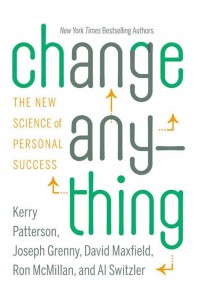From my blog post, The Difficulty of Mastery = The Difficulty of Lean, I started discussing the book, Change Anything: The New Science of Personal Success . I found the work paralleling Lean in many of its approaches and put Lean practices in parenthesis. Their strategy is based on four simple steps:
- Identify Crucial Moments (Identify Value)
- Create Vital Behaviors (Map Value Stream)
- Engage All Six Sources of Influence (Create Flow – Enable Pull)
- Turn Bad Days into Good Data (Seek Perfection – PDCA)
I stopped short of discussing the six sources of influence and have included them here:
- Personal Motivation
- Personal Ability
- Social Motivation
- Social Ability
- Structural Motivation
- Structural Ability
I am going to use a different perspective on these influences looking at it from a perspective of an organization trying to change and using Lean and my own thoughts to orchestrate the change.
 Organizational Motivation will never persist without the change being tied to the marketplace. Dan Jones recently wrote in the blogpost, How can Lean Survive that “The best chance for lean to survive a change in top management is if it is seen to be delivering significant results, not just point improvements in key processes but bottom-line results for the organization as a whole, which would be reversed if support for lean disappeared. I disagree with the statements that you just have to accept that it is going to work and not expect results. Results are the motivating factors.
Organizational Motivation will never persist without the change being tied to the marketplace. Dan Jones recently wrote in the blogpost, How can Lean Survive that “The best chance for lean to survive a change in top management is if it is seen to be delivering significant results, not just point improvements in key processes but bottom-line results for the organization as a whole, which would be reversed if support for lean disappeared. I disagree with the statements that you just have to accept that it is going to work and not expect results. Results are the motivating factors.
Organizational Ability requires learning new skills if you are going to change. If change is difficult we will take the path of least resistance. Mastering a new set of tools is never easy and that is why Lean is so powerful. Lean is based on standards, knowing how the process should work because if it’s clear, then when we see a variation from the process we can react immediately. This allows us to choose one problem from the other and just solve them one by one. This is incredibly powerful because with lean systems we rely on increasing our competency, increasing our training without having to take people off line, without having to get to classrooms, but by building it into the way we work.
Social Motivation and Social Ability go hand in hand. Employees, Suppliers, and even Customers would rather you not change. They want to deal with the known. Even voters will vote for someone that they know and disagree with over the unknown. You have to re-define the norm for example through Value Stream Mapping or an A3. You have to get those around you on board with the new ideal or without you will fall victim to those old tired out ways that have become ineffective. Surround yourself with willing partners that will push you to this new ideal. This is sometimes where a consultant can play a role.
Structural Motivation can be difficult in organizations since external goals are difficult to recognize. We can see internal improvements sometimes immediately. But these internal improvements may not result in the needle being moved in the marketplace. An effective motivator may be the fear of loss. Can you tie lost market opportunities to your change efforts? Can you demonstrate even the smallest of wins? If you can, it will significantly increase the odds of success.
Structural Ability small changes in your environment have a surprising effect on your choices. This is where Lean plays such a huge role in change. Lean is not rigorous. It uses visualization and it’s a readymade tool set that reduces the resistance to change. What Lean does require though is rigorous use to be successful.
Lean is a change tool but it is not a cure all. Dr. Balle said in an interview with me, “Lean is not a revolution; it is find one problem and solve one problem.” I wish you the best on your journey of change!



